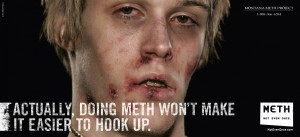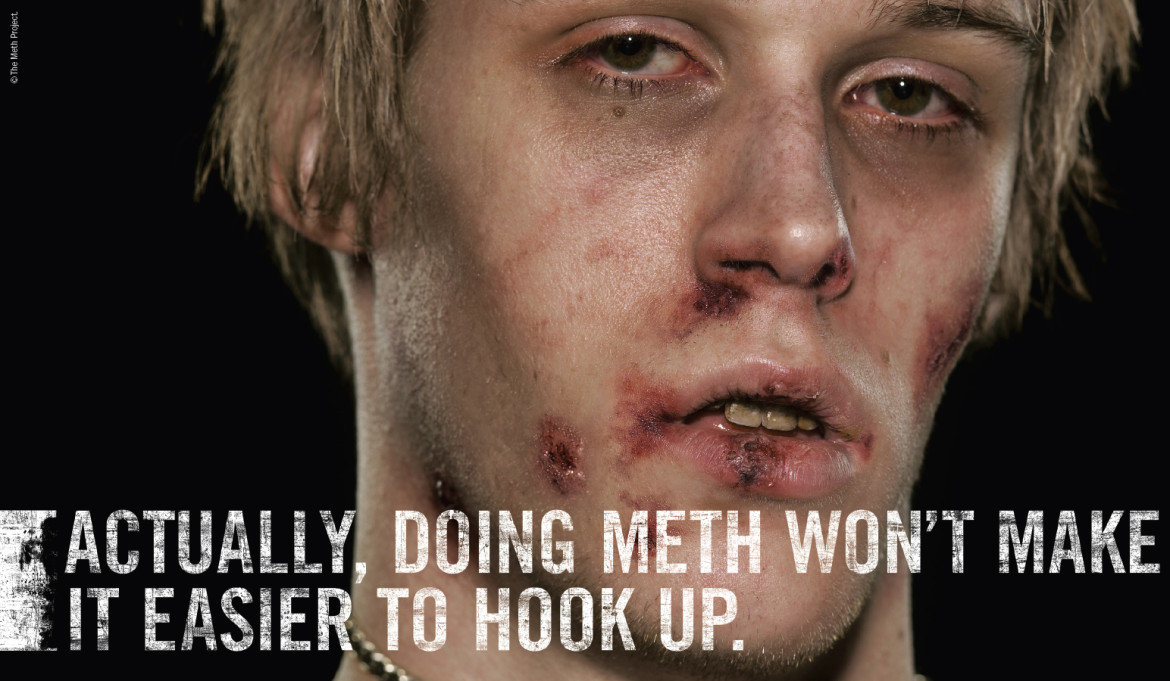
Image courtesy the Meth Project
Oct. 23 is the beginning of Red Ribbon Week, a national campaign to -- in the words of the organizers -- "unite and take a visible stand against drug abuse."
One of the substances the campaign will have no trouble getting people to stand against is methamphetamine, a drug that has ravaged the nation for years. One look at the powerful images of the effects the substance can have on a user can push one toward action.
While not in the headlines as frequently as in the past, statistics clearly show it is still a serious problem in the United States.
The Drug Enforcement Agency (DEA) seized more than 2,000 kilograms of meth in 2010, up nearly 100 percent from five years prior in 2007. In Georgia alone, DEA meth seizures increased an astounding 447 percent between 2008 and 2010. According to the Drug Abuse Warning Network, nearly 100,000 emergency room visits in 2009 were meth-related.
Meth is popular because of the short, intense rush users experience. Meth gives users energy, increases their wakefulness and physical activity, and reduces their appetite. It is, as sociologist and meth expert Dr. Miriam Boeri of Kennesaw State University says, “the perfect drug for the post-modern society.” We all have so much to do these days, she said, explaining why addicts would risk the severe, often deadly, side effects. Meth, she joked “helps you clean the house better.”
While a meth addict’s house may be cleaner than ever, their body will be experiencing a wide variety of physical ailments. Meth is not a pleasant drug for your body. According to a DEA factsheet, meth is a highly addictive stimulant that affects the central nervous system causing mood disturbances, hallucinations and delusions. Meth is also known for the extreme physical deterioration of its users. It destroys the enamel on teeth leading many meth users to have severe dental problems. It reduces users’ appetites causing rapid weight loss. Meth users sometimes give themselves deep cuts as they scratch while hallucinating insects crawling under their skin.
An aggressive ad campaign that began in Montana in 2005 and spread to other states such as Colorado, Arizona, Illinois and Georgia, is trying to raise awareness of the dangers of meth abuse among teens before they try meth for the first time. The Meth Project gained notoriety for its provocative billboards, print, Internet, television and radio ads that, with graphic detail, showed the results of meth addiction -- the bloody sores, the sexual exploitation and the dirty prison cells. The campaign’s slogan is “not even once,” an updated version of the “just say no” campaign of the 1980s.
The Meth Project began in Montana in 2005, a state plagued by meth use at that time. Before the ad campaign could begin, the Montana Meth Project (MMP) performed a bench line survey of teen perceptions of meth. Follow-up surveys were performed every few years to measure the success of the ad campaign. MMP’s internal research showed significant increases in negative perceptions of meth among teens. MMP could also point to impressive reductions in the number of teens using meth.
Still, meth use in the nation is on the decline. The number of meth users is hard to pin down, but other statistics help give a picture of the current level of meth use. Quest Diagnostics, a leading provider of drug testing for employment reported tests with positive results for meth in the workplace nationally declined from 0.18 percent in 2006 to 0.10 percent in 2010. And the DEA reports that meth use among teens fell 60 percent between 2000 and 2010.
But meth is a regional drug. Following passage of the Congressional Combat Methamphetamine Epidemic Act of 2005, which limits the sale of pseudoephedrine, a key ingredient in the manufacture of meth, meth is now most often imported by Mexican cartels. The cartels manufacture the drug in large labs and then smuggle it into the U.S., particularly Hawaii, which has the strongest presence of meth in the nation. The rural South and Midwest are also home to high levels of meth use as evidenced by the number of meth labs discovered by police in those regions. Missouri has consistently led the nation. In 2010, Missouri accounted for nearly 10 percent of all meth lab incidents nationally with more than 1,900. And while there are fluctuations from year-to-year, the total number of meth lab incidents nationally has declined significantly from more than 18,000 in 2004 to some 11,000 in 2010.
As meth use declines, for some, recovery begins, but it will take time, says addiction and recovery expert Neil Kaltenecker.
“I think the most important message about meth addiction is that recovery is possible and there are many people living full and happy lives in recovery,” Kaltenecker said.
